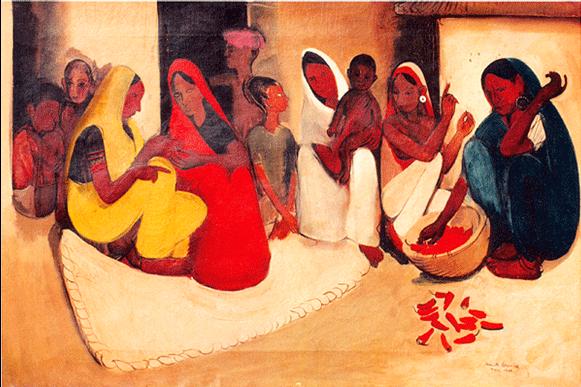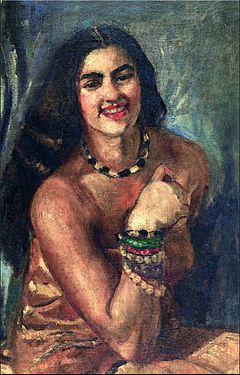The Indian Frida Kahlo

The daughter of a Sikh aristocrat and a Hungarian opera singer Amrita Sher-Gil has often been referred as India's Frida Kahlo for her aesthetically blending of traditional and Western art forms. She is considered as one of the famous painters of India and is considered as a revolutionary woman artist and the originator of modern art in India. Apart from painting, she was also well-versed in playing the piano and fond of reading. She even traveled to different parts of India, France, and Turkey and managed to incorporate ideas gained from different techniques into her own works.
Today's India's eminent new generation contemporary painter Shantala Palat shares some of the extraordinary work of Amrita Sher-Gil and the gist of Amrita's remarkable life.
Early Life
Amrita Sher-Gil came to India at the age of eight to her family estate in Shimla. In 1929, at the age of 16, she moved to Paris to study art at the Ecole des Beaux-Arts. There, Amrita – who had always displayed a rebellious streak (as a child she was expelled from her convent school for declaring herself an atheist) – plunged into everything that the bohemian Paris had to offer.
Amrita’s early paintings from this Paris period shows every sign of having been made in the Western tradition. She had long been interested in Gauguin, whose influence was so evident in her self-portraits as the Tahitian. Modigliani, Cézanne, and Renoir became important influences as well.
Her famous painting “In Young Girls” (1932) Amrita painted her sister Indira, who sits on the left side of the painting, dressed in fashionable European clothing, while the partially undressed figure in the foreground was Amrita’s French friend. The two women, one poised and assured while the other, more awkward with her face hidden beneath her messy hair, have been described as embodying different sides of Amrita herself. “In Young Girls” was highly praised by critics and people were impressed by her way to convey various tonal variations of the white color. In the year 1933, “In Young Girls” won the gold medal at Grand Salon. Despite the prestigious recognition in Europe, Amrita gradually found herself drawn to India.
In the early nineteenth century, traditionally Indian art tended to be sketchy and sentimental. Amrita was determined to find a new way of showing India, the country her father had taught her to love. She once said, “There are such wonderful, such glorious things in India, so many unexploited pictorial possibilities, that it is a pity that so few of us have ever attempted to look for them even (much less interpret them)”.

Three Girls
In the year 1935, Amrita-sher-Gil painted her signature creation “Three girls” that showed three young Indian women sitting passively as if waiting for their future to appear. The mood of the painting was far from joyful, the shadows on the wall suggested that the girls’ anticipated lives – complete with husbands and families – may not bring the happiness that their culture taught them to expect.
Then she painted the “Bride’s toilet” that showed a young bride surrounded by female relatives as she prepares for marriage, her pale body contrasting strongly with the rounded fecundity of the figure to the right. The painting captured the isolated lives of Indian women whose inner worlds seethe with boredom, resignation and frustrated desires.
In the year 1941, at a mere age of 28, Amrita Sher- Gil died after a serious illness which made her slip into a coma. Despite her short career as an artist, Amrita Sher-Gil remains one of the most captivating, curious and alluring artists of her time. Apart from “Three women” and “Bride's Toilet”, some of her other famous paintings are “Self-Portrait as a Tahitian”, “Hungarian Gypsy Girl”, “Sleeping women”, “Brahmacharis” and ‘South Indian Villagers Going to Market’.
Even though Amrita Sher-Gil lived for a short span of time, her work got the recognition both in India and the rest of the work. The government of India has declared her work as National Art Treasures. Most of her paintings adorn the National Gallery of Modern Art in New Delhi. Though her paintings were largely unsold while she was alive, they fetched the impressive amount of money, later on, making her one of the expensive Indian women painters of all times. In 2006, ‘Village Scene’ sold for a whopping 6.9 crore rupees in New Delhi. Back then, it was the highest amount paid for any Indian painting in India.

About the author: Shantala Palat is a Delhi based, new generation contemporary artist whose work has recently gained popularity after participating in series of international and national exhibitions and
winning the prestigious Nippon art award (2011) from School of Art Institute of Chicago, USA. In 2013, she had her first solo exhibition at Hamra Centre, City of West Torrens Auditorium Gallery, Adelaide, Australia. Shantala’s artworks were appreciated for their vibrant and vivid colours and the interesting ability to beautify the negative and positive spaces of the interlocked figures and for portraying the curious nature of the modern human being.

































